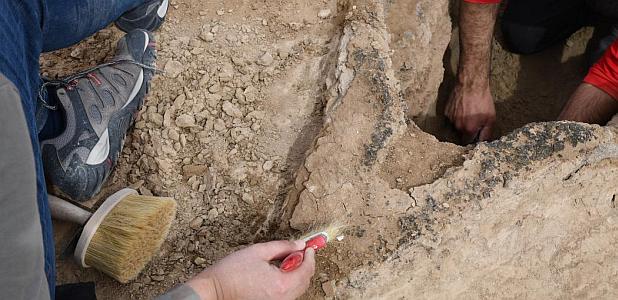
Photo: Deutsches Archäologisches Institut
When the burial ship at Sutton Hoo in the UK was uncovered in 1939, the ship itself was missing. The wooden planks and frames of the ship, dating from around 600 AD, had rotted away. Nevertheless, an almost intact impression of the hull was left in the hard-packed soil.
Now the remains of a Mesopotamian boat, estimated to date back 4,000 years, have been discovered. Like the Sutton Hoo ship, the organic material that made up the boat’s hull had rotted away, but the boat’s form was preserved by the waterproof coating of bitumen that had originally covered the hull.
The largely intact 4,000-year-old Mesopotamian boat was discovered in excavations of the ancient Sumerian city of Uruk by a joint German-Iraqi team. The Deutsches Archäologisches Institut describes the boat as 23′ long and up to 4.5′ wide. It is not thicker than 3/8″ in many places. The organic remains are no longer preserved and are only visible as imprints in the bitumen. During the excavation, the boat was documented three-dimensionally by photogrammetry. The archaeological context shows that it sank at the bank of a river that has since silted up, probably about 4000 years ago, and was overlaid by sediments.
From the boat’s archaeological context, the team determined that it is likely around 4,000 years old, which would place it toward the end of the Ur III Period (c. 2112–2004 B.C.E.) or the beginning of the Isin-Larsa Period (c. 2004–1763 B.C.E.). Due to fear of additional damage, the team covered the boat in a clay and plaster shell before excavating it completely. The boat is expected to be brought to the Iraq Museum in Baghdad where it will be studied and displayed.
Biblical Archeology notes that the Mesopotamian city of Uruk—Unug in Sumerian—was one of the oldest and most powerful cities in the land of Sumer (southern Iraq). Although in antiquity the city sat along the banks of the Euphrates River, Uruk is now covered in sand, the bed of the Euphrates having long ago shifted its course. The city rose to great power in the fourth millennium and, for a time, it was possibly the largest city in the ancient world.
Thanks to Roberta Weisbrod for contributing to this post.
